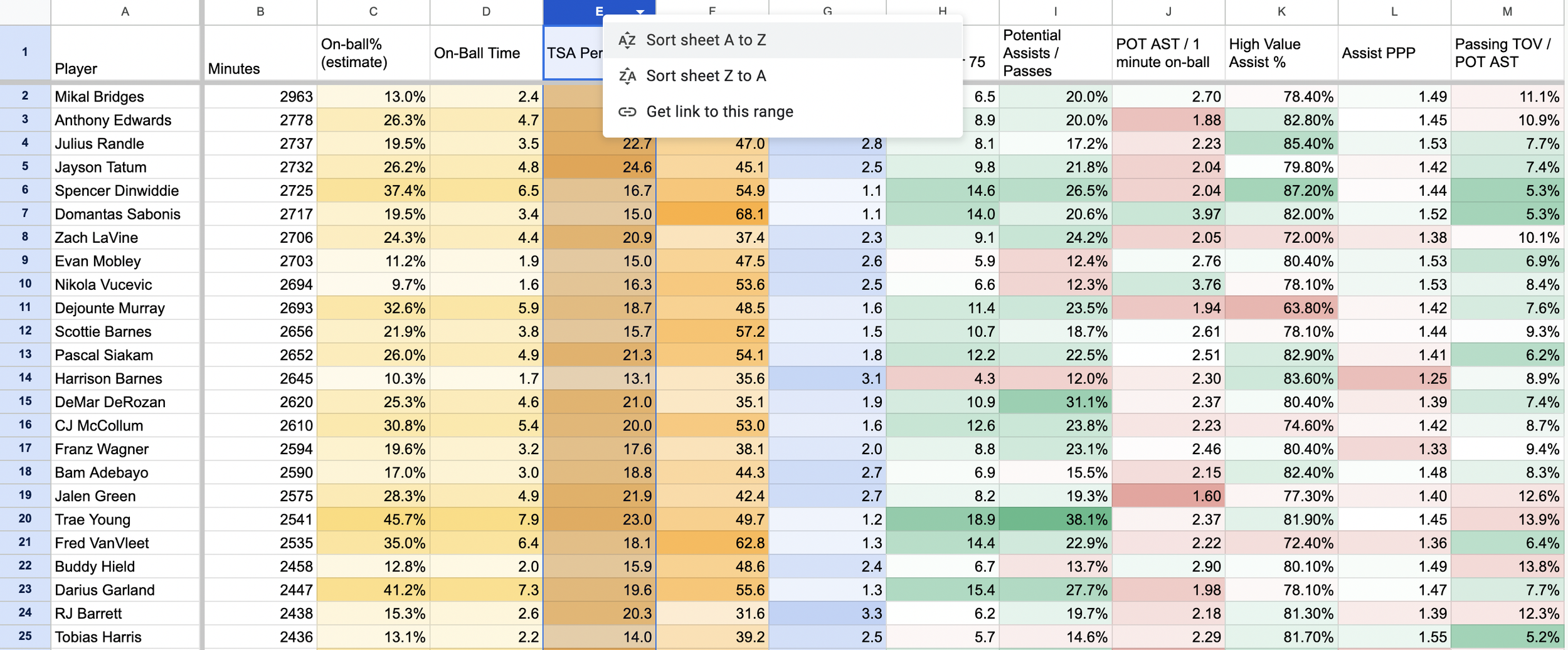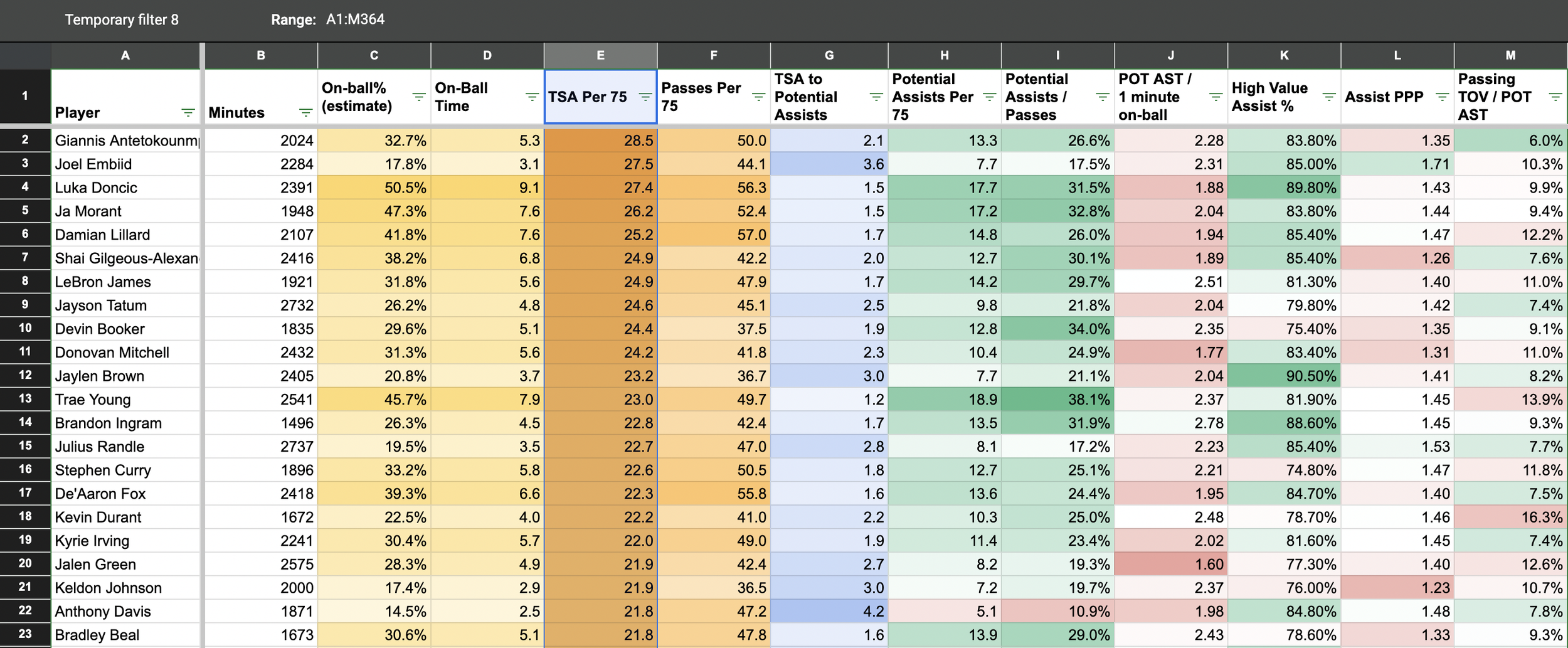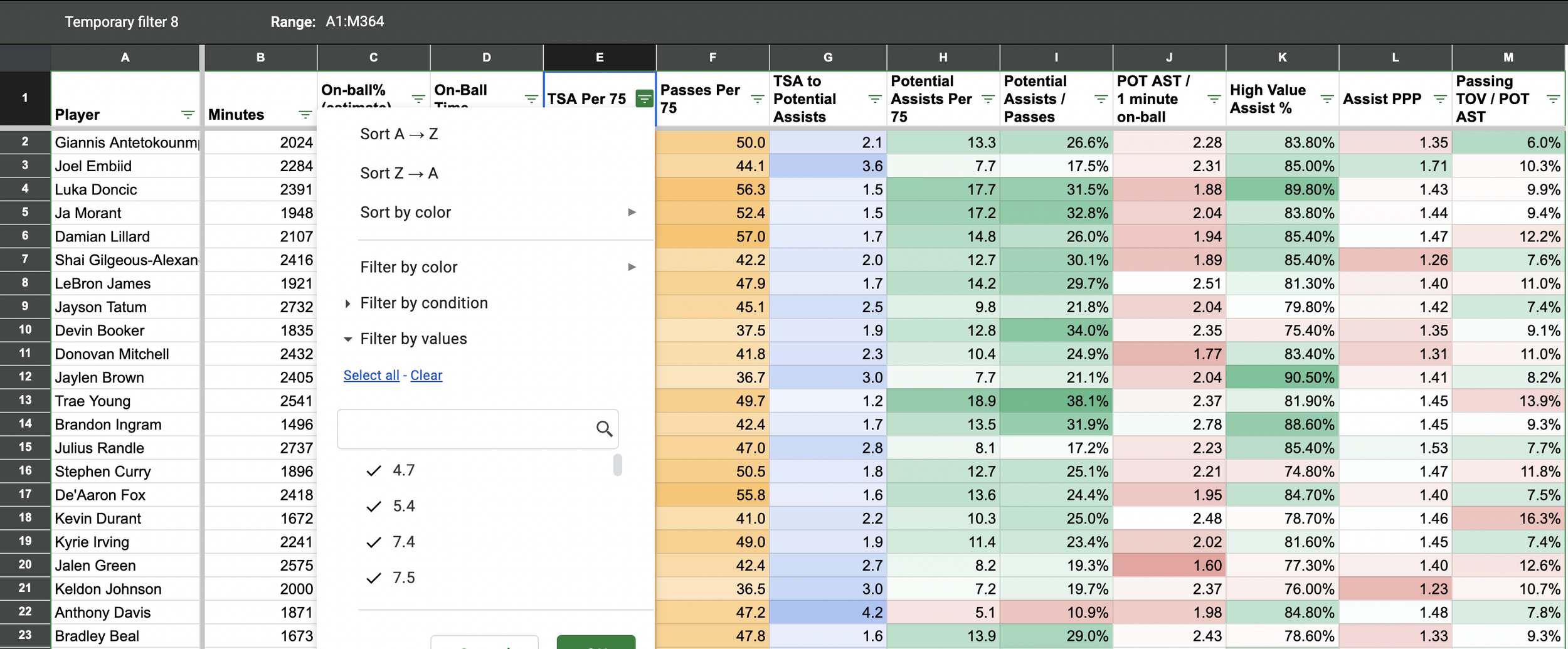Better Passing Stats
Assists are a poor measure of passing/playmaking, and with a full season of data now in tow, I finally put together an idea I’ve had for some passing “stats”. Rather than introduce a superior catch-all alternative to assists, I drew on publicly available tracking data to better contextualize passing numbers. It can be accessed here, and looks like this:
These are the top-28 players in minutes played
To play around with the data, do as follows (if you know Google Sheets, then you can likely skip this):



Now, if you want to check out the data, go ahead! That’s the fun part. However, if you’d like to hear about my thought process behind each number, with (hopefully) some insight on how to interpret what you’re seeing, keep on reading.
Basketball can get complicated, so let’s unpack. The words “passing” and “playmaking” can often get used interchangeably, but in order to properly turn thoughts into words, our language needs to be precise.
Passing: Passing, to me, means passing ability. Of the (perhaps) infinite types of passes that exist, how many can you make? Passing requires both technical skill, i.e. the ability to get the ball from Point A to Point B, and feel, specifically the ability to read the floor, find the passing opportunity, and devise a plan to exploit it, all as quickly as possible. So, we could imagine something like: Passing Ability = Technical Passing Skill X Passing Feel, perhaps imagining quantitative passing ability as the % of all scenarios where a player can make the right pass.
Playmaking: Playmaking, to me, refers to the volume of impact a player makes with his passing. Players who create more, aka draw more help, naturally get more passing opportunities. For example, let’s take Giddey and Luka/Trae/Jokic. These 4 players all have similarly god-like passing abilities, yet the latter 3 end up playmaking a lot more, as they’re also world-class scorers. I imagine something like: Playmaking = Passing Ability x Passing Opportunities. So Playmaking, the product in my equation, is probably what’s actually getting measured by real-life assists (or, rather, potential assists).
Essentially, what I’m trying to do here is add as much context as possible to essentially one stat - assists - by skinning the cat in all sorts of way. I’m going to give a quick blurb on every stat I included, and why. But first, disclaimer: I’m using potential assists instead of assists. As one might imagine, potential assists are, well, potential assists, capturing the made & missed shots assists as opposed to just the makes. It gives you a more accurate idea of volume and somewhat adjusts for teammate quality. The one weak spot would be “grenade” passes, but oh well.
If you’re a player who played at least 500 minutes this NBA season, you’re on the sheet. Now, what am I tracking?
On-ball% (estimate)
What it is: This is my estimate for what percentage of time (on offense) a player spends on ball. It’s 2 x on-ball minutes / total minutes, making the assumptive leap that a player’s time on the court is evenly split between offense and defense.
Why it’s here: The percent of time a player spends on-ball can help as a proxy for role, for the creation duties are asked of them and how much time they spend trying to create, which contextualizes their playmaking data.
On-Ball Time
What it is: Minutes spent on-ball per game.
Why It’s Here: It’s another, more tangible way to look at time spent on-ball.
POT AST / 1 minute on-ball
What it is: Self explanatory. POT AST means potential assists.
Why It’s Here: If time on-ball is a creation proxy, then this is a way to contextualize potential assists against creation. As a rate stat, it works well for comparing the playmaking efficiencies (efficient use of time) among players with similar on-ball loads. Also, by identifying guys who turn touch time into potential assists for teammates at a prolific rate, you might be looking at talented connectors/secondary playmakers (Draymond is way at the top with 6.6, Batum and Horford are just below him). Further insights are spread throughout. For example, despite being a brilliant passer and high volume playmaker, Luka only averages 1.88, placing him around the 10th percentile. This highlights a certain inefficiency in his game - his need to dominate the ball to be productive - that few other stats can capture.
TSA Per 75
What it is: True Shooting Attempts per 75 possessions (always standardize!).
Why It’s Here: Passing and scoring are yin and yang. Seeing how often a player shoots, which increases (albeit nonlinearly) with creation, is quintessential to contextualizing their passing.
TSA :: Potential Assists
What it is: TSA / Potential Assists, the # of shot attempts to one potential assist.
Why It’s Here: See above. It’s measuring a player’s basic frequencies.
UASTDM / 75
What it is: Unassisted Makes per 75 possessions.
Why It’s Here: Shot attempts won’t always tell you much about creation. Some players are more off- or on-ball orientated. Unassisted makes, however, better lines up with creation duties, making it yet another creation proxy to contrast playmaking with.
Potential Assists :: UASTDM
What it is: Potential Assists / UASTDM, the # of potential assists to one unassisted make.
Why It’s Here: Trying to capture how often a player is creating for himself vs for others. More useful as a relative stat when comparing passers. It also captures guys who playmake a lot without much creation juice. Dray’s ratio is 34(!), Batum’s is 14.5 (only 8 players are above 15).
Passes Per 75
What it is: Self-evident.
Why It’s Here: How often a player passes is basic context for how many measurable productive passes they have.
Potential Assists Per 75
What it is: Pretty obvious.
Why It’s Here: This is the stat that my entire project’s about.
Potential Assists / Passes
What it is: Quite apparent.
Why It’s Here: The percent of a player’s passes that end up as potential assists, especially in tandem with their passes per 75, can help us see which players are constantly putting pressure on the defense through their passing. You see a lot of ball-dominant players at the top.
High Value Assist %
What it is: The percent of a player’s assists that are 3’s and layups.
Why It’s Here: While the midrange is far from dead, it’s simply not where players spot up anymore. Playmaking is supposed to be setting a teammate up with a high quality shot, and feeding a teammate an assisted middy doesn’t imply the best creation process, as you didn’t create a high-value assisted shot. The stat is kinda like a bullshit meter, filtering out some noise. Bigs score quite badly in this, as I imagine they get a fair share of assists acting as DHO hubs and such. Which goes back to my original point, that this stat can sniff out assists where the player in question isn’t doing much playmaking - not creating the opportunities nor uncorking ingenious passes.
Assist PPP
What it is: The points per shot on a player’s potential assists.
Why It’s Here: While teammate quality certainly plays a large role here, this has a similar function to the previous stat. I wouldn’t split hairs over the numbers here.
Passing TOV / POT AST
What it is: Passing turnovers to potential assists, expressed as a percentage.
Why It’s Here: This one gets me excited. Turnovers can be extremely misleading, as they often increase in tandem with creation duties as a natural byproduct of an expanded role. It shows the ratio of players’ misses to hits. It’s a similar idea to AST:TO ratio, except that this measurement is far more accurate. It can show you who’s missing the mark, and who’s not.
First, shoutout to Gabriel Guzman (@GabeLeftBrain), who pulled all the necessary data for me. This doesn’t happen without his help. And, as always, thanks for reading. If you enjoyed, a share on Twitter would be much appreciated. If you have thoughts on any of this, hit me up (again on Twitter) - I’d love to discuss. Wishing everybody a happy PlayoffSZN.
